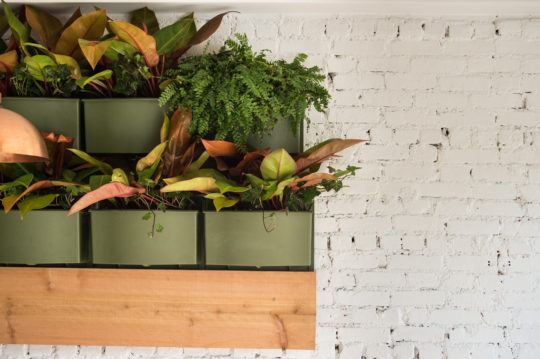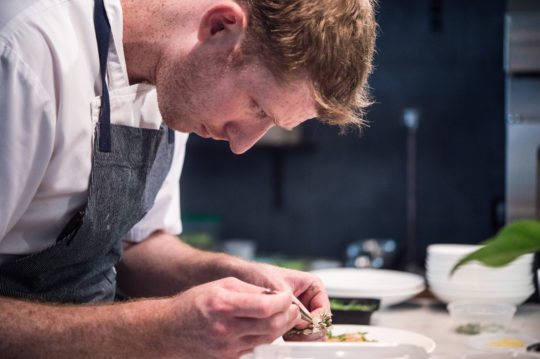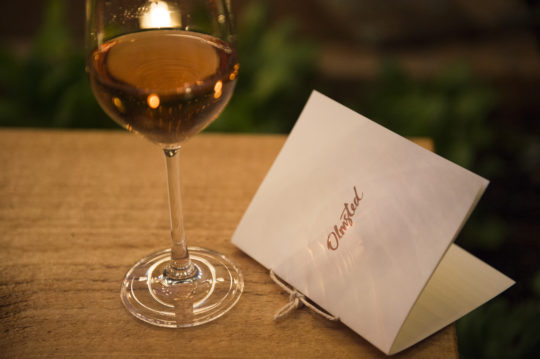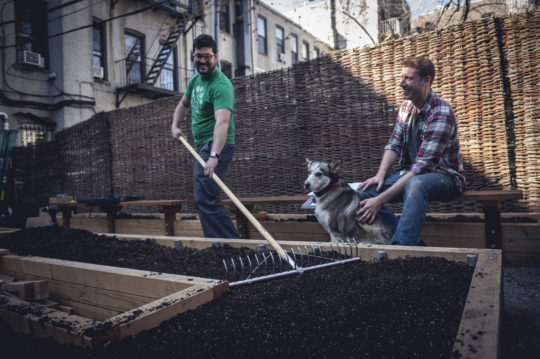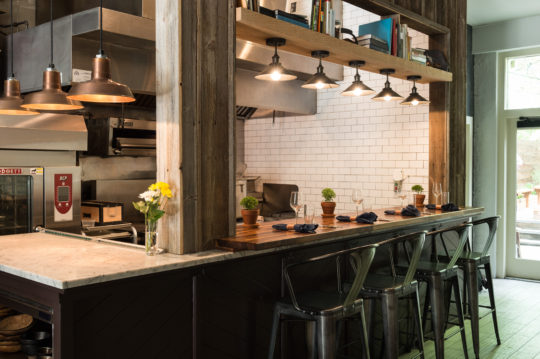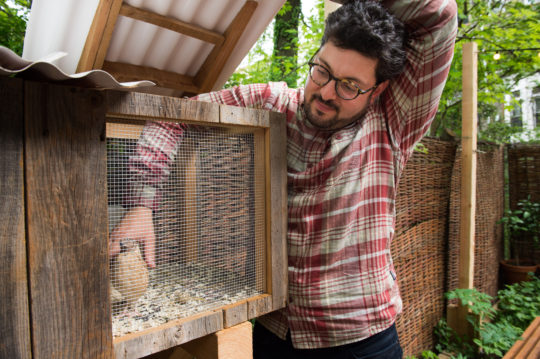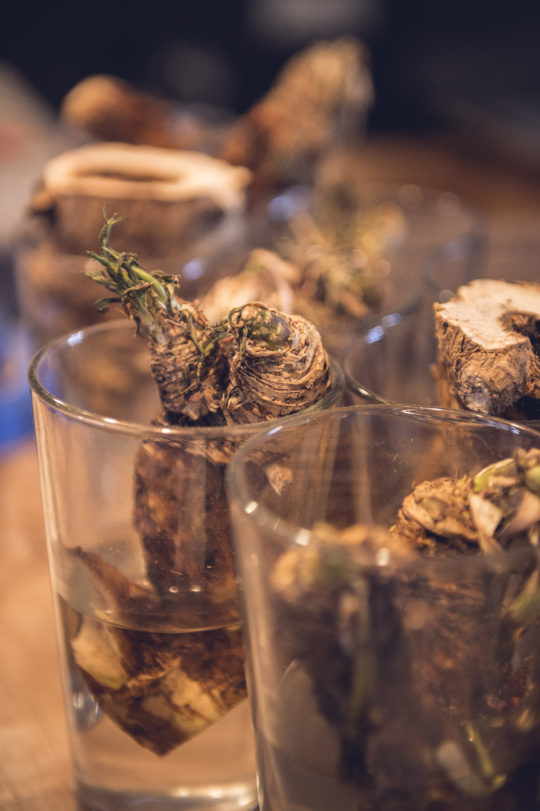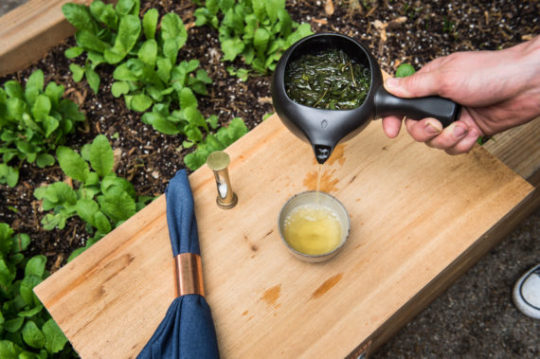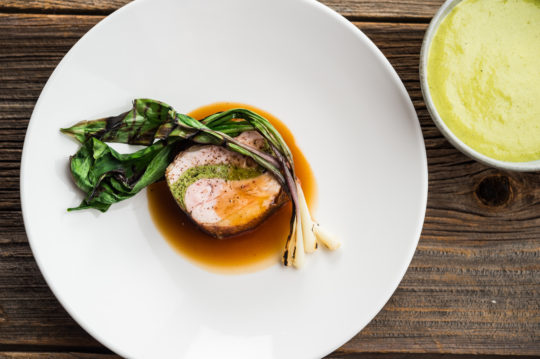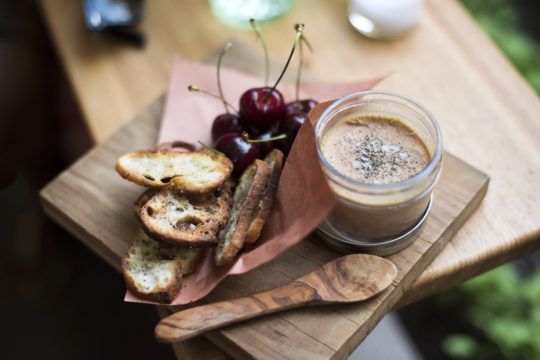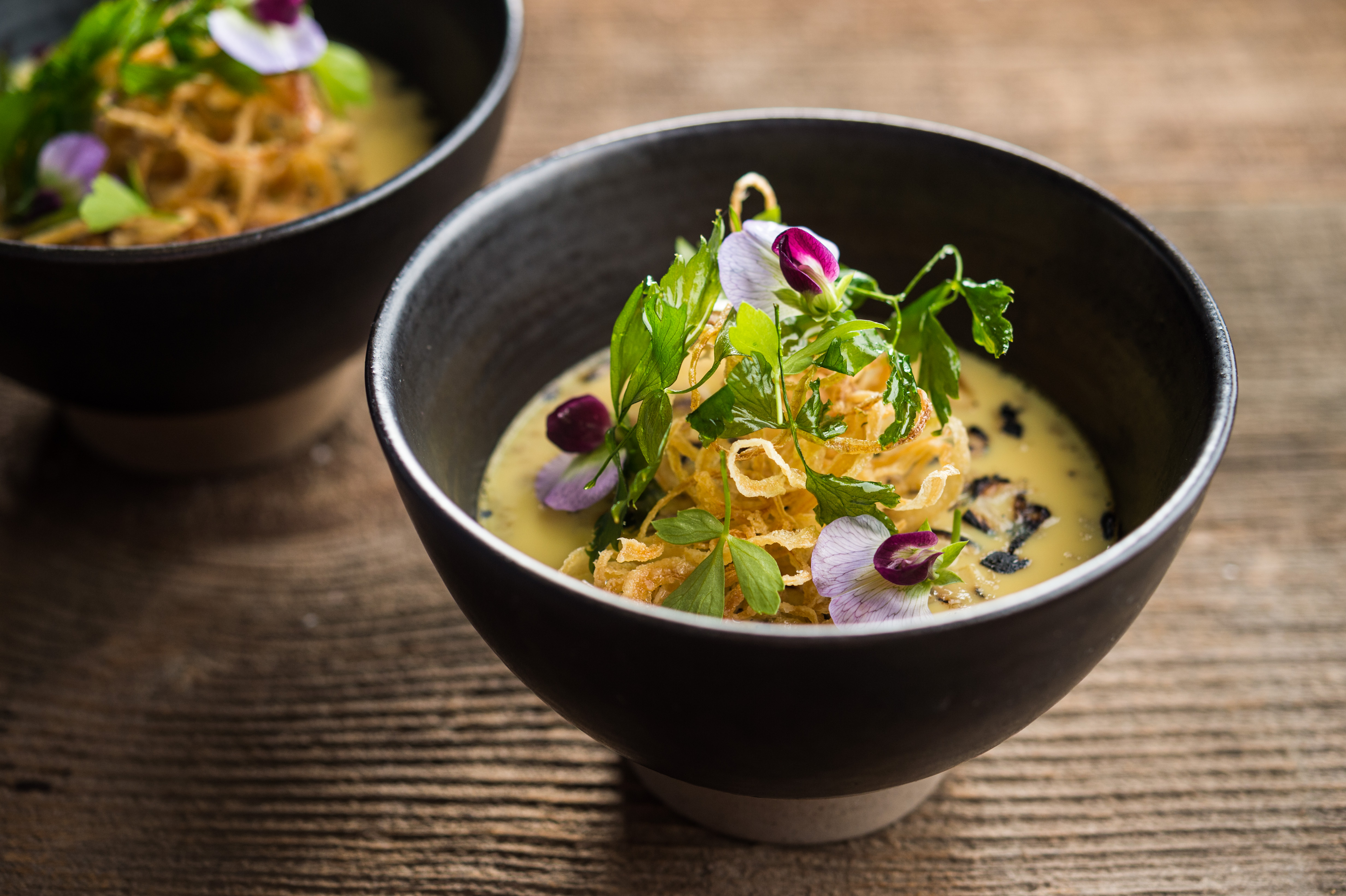Photographs courtesy of Evan Sung.
Greg Baxtrom and Ian Rothman are a chef/farmer duo who are partners in Olmsted, a 50-seat ingredient driven restaurant in Prospect Heights, Brooklyn.
Can you tell us a little bit about where you grew up and how you got interested in food?
IR: I’m from West Hartford, in Central CT, a middle class suburban neighborhood. None of my friends or family were raised in an agricultural family. When I was in middle-school my grandmother passed away. We went to her estate to claim a few things that were meaningful to us, I picked a dumb cane, which is a common house plant and a couple of chairs. This plant stayed in my room all through Middle School and High School. When I brought it to college, it promptly started dying, leaves and branches yellowing and falling off. It had a lot of meaning to me, so I went to my friend who had a room full of plants and asked her to help me save this plant. So we took cuttings, rooted them in water, transplanted them into sand and potted them back into soil. The whole process worked, intrigued me, and that was exciting. I wanted to know how she learned it and she said in an organic farming/gardening class that she had taken. So that next semester I took that class and it opened up the world of farming to me in college. Now in the restaurant, we have dumb cane plants represented on our living wall.
GB: I grew up in the suburbs of Chicago, 30 minutes south of the city. It was a pretty small town, my parents bought a small farmhouse when they got married. It had a barn, silo, corn crib and a chicken coop, but they didn’t farm it. Someone else had bought the surrounding farm land. It was a pretty suburban life, but surrounded by cornfields.
I grew up on fast food 3 or 4 nights a week and don’t think I had a mushroom until I was in culinary school. I got into cooking through the boy scouts. When I started something I wasn’t allowed to quit, even when I had a good reason. So, 18 years in the boy scouts. As you get older, you have to start cooking three meals a day when you’re out camping, which I was doing for weeks if not months at a time since I was young.
Just like setting your tent up properly or rolling up your sleeping bag so it fits in the compression sack just right, I started to like that challenge of making the beef stew better than the other guys bringing theirs in a can. So then, after noticing that, and doing a couple of boy scout culinary competitions, there was a summer camp at Kendal, the culinary school I ended up going to, and it confirmed for me that I wanted to cook. I started right out of high school.
Can you share some of your career highlights?
GB: My first job was at Wendy’s. I started off as fry cook, I liked that station, but one time I got really badly sunburned and it was hard to reach under the heat lamps. That experience stuck with me.
IR: He hasn’t been outside since!
GB: After Wendy’s I went to a country club, but my options were limited as a 15 year old kid. While in culinary school, I did three different, three-month internships. One in France, another was at a bakery, Fleckensteins, in Mokena, run by two master bakers. After that, I went to Alinea. It happened to be the very beginning, Grant (Achatz) was testing food at Nick Kokonas’ house and I didn’t understand what I was looking at, but it was on Halsted (Street) and I lived on Halsted and my culinary school was on Halsted, so….
So your first real kitchen job was at Alinea?
GB: Yeah, I guess so. I worked an unusually long time without getting paid. Grant milked that as long as he could. It wasn’t until I graduated culinary school that he started paying me and even then it was like $21,000 a year. $300 a week or something like that. I was there for three and a half years. Then I left to jump around, mostly because I set up a stage at Mugaritz. If you could find a place to stay at that time, you could make it a few months on very little cash. You just needed to buy beer and a coffee once a day. I got housing so I stayed at Mugaritz for three months, then staged at El Bulli and Arzak as well.
I came to New York and worked at Per Se. After some time, Grant ate at Stone Barns. Dan Barber asked him if he knew of anyone looking to move up. Grant recommended me, the move felt like the right opportunity so I took it. After two years at Stone Barns, I spent four years bouncing around, learning how to approach build-outs and open restaurants. I did that at North End Grill, Atera, Lysverket and worked as a private chef for two years.
How about you Ian?
IR: After university I founded an organic vegetable farm in the Berkshires in Massachusetts. I did that for five years. Then I moved to New York and the first job I got was at Dickson’s Butcher Shop in Chelsea Market. I saw it as a way to pay rent while still supporting farmers and agriculture. While working there I met Kate Galassi, who had been working for Compose, the restaurant in the space Atera would take over. Kate said “You should meet this new chef, he’s from Portland and loves agriculture and food. It started with a coffee with Matt (Lightner) and talking about how to create access to the outdoors when there is no outdoors to access. We came up with the (indoor) garden in the basement of Atera and that was almost four years. After that I started working with other restaurants to build green spaces.
How did you two know you wanted to work together?
IR: We were both in unique positions (at Atera). I wasn’t part of service, although I was working a lot, there was some flexibility in when I had to be there. Greg was there just to lend a hand to anyone who needed it, I worked in this refrigerated room, and while everyone was silent in the main kitchen, everyone would come into the cold room to vent for nine minutes and then go back out. Everybody talked to me.
So Ian was like the therapist?
IR: It was pretty wild. In that room talking was allowed for whatever reason. Greg had grown up surrounded by farmland and I liked farmland and we started having conversations.
GB: It really came from me asking questions and picking his brain. How do I make this farm (at my parents house) that can service my restaurant?
IR: We started planning that and taking every single layer that we could and peeling it back and back and back and rebuilding it and talking about how to make a farm that would support a restaurant.
GB: A couple of years ago, I remember talking to these friends of mine — not industry people — just friends asking what I wanted my restaurant to be like. What do you want your guests to feel. My answer would be ‘challenged or intrigued or confused’ (laughs) All these stupid things. Bill Kim said that to me in Chicago – keep your parents in mind when you open up a restaurant. Do you want them to feel uncomfortable in your own restaurant? It took four years for me to really understand that I don’t want a sterile environment where it’s just about me and my food. It’s almost the opposite. Now we just want to create something special and appealing. Not — here’s this box of everything that we’ve learned and either you get it or you don’t sort of thing.
Who are some chefs or people in the industry you consider mentors?
GB: For me Grant (Achatz) is by far my biggest influence. For whatever reason he took me under his wing when I was there and I’ve always been able to go back to him and Nick for advice. We’ve always stayed in touch. I don’t know how I got that lucky.
As we know, Grant came in to eat recently. What was that experience like?
GB: He came up to me and we hugged each other and I said, “I’m terrified. I want to throw up a little bit.” And he just laughed. He couldn’t have been more supportive though. His reservation was 6:00 in the beginning. I took that as meaning he had something to do afterwards, and he was squeezing it in. Then he changed it to 8:30 – but I still had the same mindset, that he gets bombed on all the time. He has such long experiences. He has other things to do, so I was sending out the food as fast as possible basically.
He just refused to move onto the next thing until he was finished and he just sat here for five hours and we closed the restaurant and he just hung out for another hour. When it was over I had to go outside by myself and sit for a minute. It was a huge thing for me. It’s funny because I was on such a high that Tuesday, I was telling everyone. What did he say? He wouldn’t tell me anything negative. I was just like… forget the critics, nothing else matters. Of course, that day I turned around at 5:30 and I’m in the shits and there’s a major restaurant critic.
IR: For me, having come from the farming world, I really had no idea what I was getting into when I met Matt and signed up to be a part of the Atera team. What it meant to work for him or that kind of restaurant, trying to be the best in the world. I remember one of the first months telling Jamie (Young, former Atera chef de cuisine) “I don’t know what I’m doing – I have all this kitchen work and I don’t know how to complete it”. Jamie said you have to watch Michele Bras – Inventing Cuisine. That will help you to understand what’s happening here. I went home and I watched it and watched it again, I probably watched it over a dozen times over the course of my tenure at Atera, because it was a world I had no interaction with previously. Since then, I’ve come to understand better how restaurants at the highest levels work.
The garden at Olmsted is one of the most beautiful and Instagrammed places in the New York this summer. Can you tell us about what you have going on there?
IR: It’s set up in two beds. The outer bed is an example of things we use. Sunchokes, fiddlehead ferns and asparagus. But just a few feet of each. It’s not enough to support the restaurant. Then the inner bed is our actual growing of a product to support a dish on the menu. We’re planting radishes on a five week cycle and it’s very lucky that it’s actually worked out that the greens are sufficient to supply all we need. It’s really exciting.
GB: There are a few things that it can keep up with like the lemon balm and nasturtium — it’s more functional than I would have ever expected.
How about the quails? We know they are pets and not food, but are you able to use the eggs?
GB: One of the first things that Ian did while we were building this thing is plant some horseradish. He rooted it and it grew and we do this french toast thing – pain perdu — we caramelize it and put a quail egg on top. Just one bite and we try to do it when we can.
Olmsted has an impressive tea program. Can you tell us how that came about?
IR: That was just about having a relationship with Jeff (Ruiz), who also did the tea program at Atera. That was our way to bring Jeff into the project. And let him showcase what he’s passionate about.
GB: For me it’s two parts, the more talented people with skills around, the more you want to give them the opportunity to share what they’re passionate about. We like Jeff and he has a thing for teas so why not let him have an outlet for that. And then with the garden, we wanted something lunch related… like tea time in the garden.
Who are some favorite purveyors you’re working with?
IR: Mauer Farm provides our Guinea Hen – it started small buying 25 hens a week. But it grew and we’ve literally dwindled their stocks.
GB: She said thank you – but now I have to close for a while.
Do they only raise Guinea Hens?
IR: I think Guinea Hens is their thing. We had to take a break because it was so successful. But the cool thing is — it started out we had this dish on the menu – Guinea Hen Two ways.. really great, but as we grew, so was the amount we were able to buy.
GB: She also has all these eggs that she didn’t want to fertilize because she didn’t want the farm to get that big – and there is no market for guinea hen eggs – starting out I had never even thought about them, but now we buy them for the chawanmushi. And we’re using the livers in a mousse we run 8-10 jars a night.
IR: Through this one relationship, we have three dishes.
Can you share some of your favorite New York restaurants with us?
GB: I love Casa Mono – it’s been a while since I’ve been been there, but the razor clams when they have them are a favorite. Just roughly chopped garlic and lemon on the plancha.
IR: I’m going to go with my staple. Blue Ribbon Bakery + Kitchen – I spend a lot of my free time there. They offer pulled pork as a topping and it’s amazing. I’ll pretty much add it to anything.


